PGIM India Balanced Advantage Fund: A suitable hybrid fund in current market conditions

Current Market Context
Equity market has enjoyed a long bull run for past 2 years. The leading indices are near all time highs. The broader market has outperformed the Nifty 50. As per AMFI data, in May 2024, assets under management (AUM) in midcap funds crossed AUM of large cap funds for the first time. When market is at record high, there are concerns about valuations. In such market conditions, asset allocation can reduce portfolio volatility and provide stability. Balanced advantage funds, which manage their asset allocation dynamically based on market conditions, can be suitable investment options when valuations appear stretched.
How Balanced Advantage Funds work?
By lowering net equity allocations when the market valuation is high, dynamic asset allocation aims to reduce downside risk if the market corrects after peaking. Similarly, BAF will increase its net equity allocations and decrease its debt allocation as equity valuations fall (become cheap). By increasing equity allocations when valuations are low, the dynamic asset allocation model may generate higher risk adjusted returns for the investor.
There are various asset allocation models within the BAF category. Some funds use technical indicators e.g. momentum indicators to tactically change asset allocation. A lot of balanced advantage funds do not disclose their dynamic asset allocation models or disclose partially. You should try to understand the asset allocation model of the fund before investing.
Balanced advantage funds usually cap their debt allocation to 35% so that the scheme can enjoy equity taxation. If the net equity exposure needs to fall below 65% as per the dynamic asset allocation model, these funds use hedging to reduce the net equity allocation, but keep the gross equity exposure above 65% to ensure equity taxation.
About PGIM India Balanced Advantage Fund
PGIM India Balanced Advantage Fund was launched in February 2021 and has Rs 1,127 crores of assets under management with a total expense ratio of 2.14% for the regular plan (details as on 31st July 2024). The fund has given around 12% CAGR returns since inception. A. Anandha Padmanabhan, Vinay Paharia, Utsav Mehta, Puneet Pal and Chetan Gindodia are the fund managers of the scheme. The fund managers have combined experience of over 80 years.
Dynamic Asset Allocation model of the PGIM India Balanced Advantage Fund
Asset allocation for PGIM India Balanced Advantage Fund is guided by a Dynamic Asset Allocation model. The fund dynamically changes its asset allocation based on the deviation of the current P/E ratio of Nifty 500 from the long term average P/E of the index (as shown in the graphic below). 15 year rolling P/E of Nifty 500 Index is considered for the long-term P/E average, whereas the current PE is the last 20 days moving average.
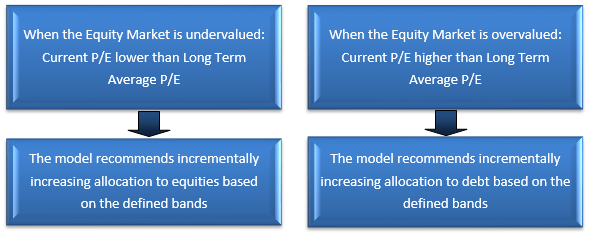
PGIM India Balanced Advantage Fund’s dynamic asset allocation model is scientific and transparent. Using this model, PGIM India Balanced Advantage Fund follows the “Buy Low, Sell High” mantra, allocates across equity and debt based on the market valuations. The fund maintains minimum 65% exposure to equity and equity related instruments (this ensures equity taxation for the fund), with directional equity exposure of at least 30% at all points of time.
Current Nifty 500 Valuations
PE ratio of Nifty 500 is currently (as on 31st July 2024) close to the long term (15 year) average PE ratio.
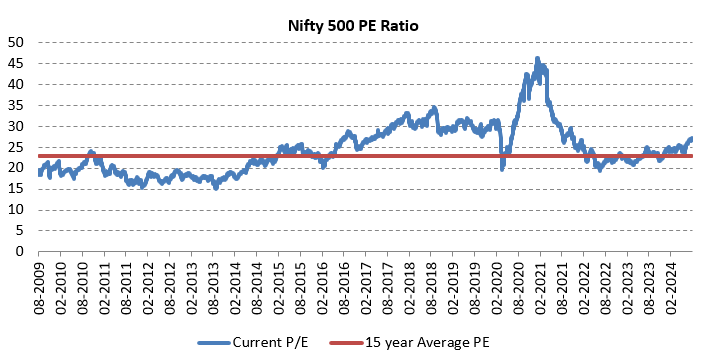
Source: National Stock Exchange, as on 31st July 2024
PGIM India Balanced Advantage Fund limited downside risk
We looked at the performance of the fund in the months when the market (represented by Nifty 50) was down (see the chart below). You can see that the fund was almost always able to limit downside risks for investors.
All figures in percentage

Source: Advisorkhoj Research
Outperformed category average across different market conditions
The chart below shows the 2 year rolling returns of PGIM India Balanced Advantage Fund versus the BAF category average since the inception of the fund. The median 2 year rolling return of the fund was 7.31%, while the category median was 6.02%. The fund had been underperforming over the past few months, but has caught up again in June / July of this year.
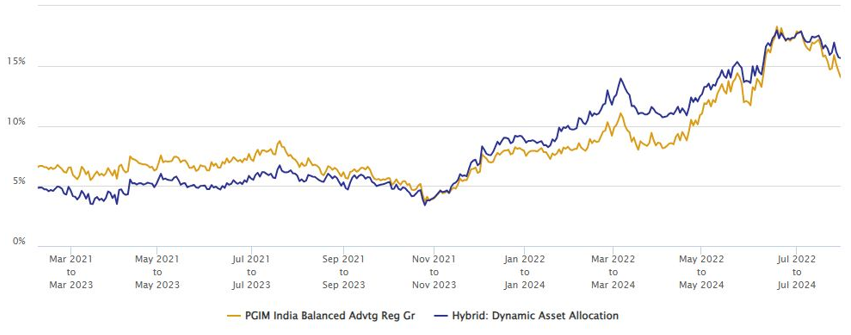
Source: Advisorkhoj Rolling Returns
Outperformed other asset classes
One of the reasons why balanced advantage funds are preferred by many investors is that, these funds have the potential of giving higher returns than traditional fixed income investments and at the same time experience lower volatility compared to equities. We have already seen that the PGIM India Balanced Advantage Fund was able to limited downside risks for investors. Let us now see how this fund performed versus other asset classes since the inception of the fund.

Source: Advisorkhoj Research, Period: 8th February 2021 to 31st July 2024
You can see that the fund outperformed the other popular asset classes, with lesser volatility relative to a pure equity asset (fund).
Asset allocation –PGIM India Balanced Advantage Fund versus peers
The net equity exposure of PGIM India Balanced Advantage is 68.49% (as on 31st July 2024). The chart below shows the asset allocation of the fund compared to the asset allocation of the 12 largest BAFs (by AUM). PGIM India Balanced Advantage Fund had higher net equity compared to the larger sized peers. Higher net equity levels imply that the model sees the current markets as sort of at equilibrium with risk and reward equally factored in and does not anticipate a sharp and lasting correction in the Indian markets.
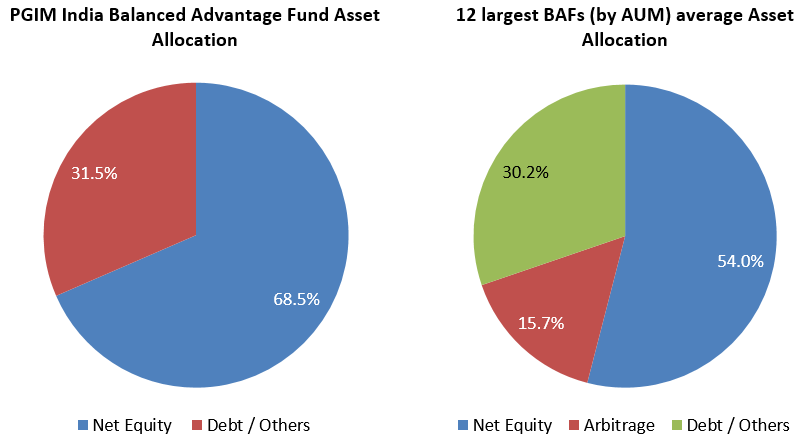
Source: PGIM July Fund Factsheets and portfolios, Advisorkhoj Research
Fund performance since inception – lump sum
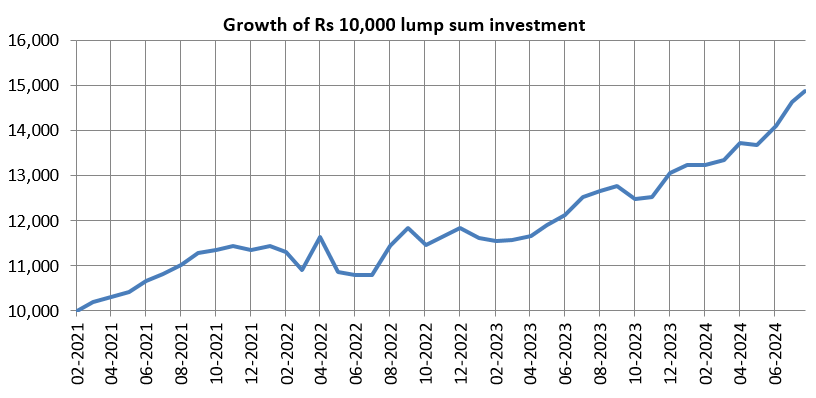
Source: Advisorkhoj Research, as on 31st July 2024
Fund performance since inception -SIP
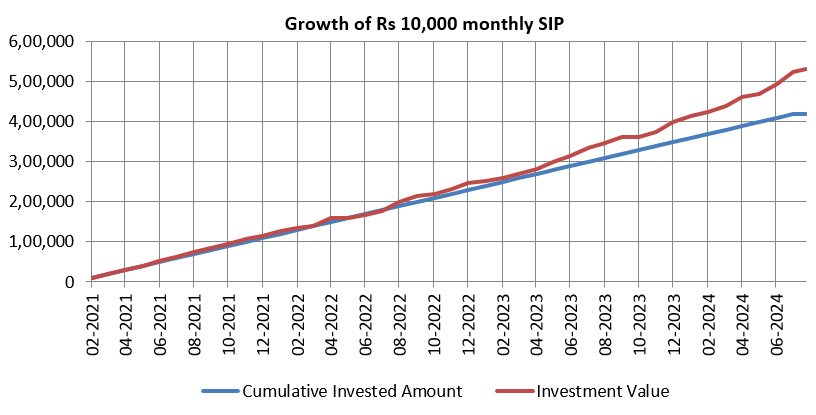
Source: Advisorkhoj Research, as on 31st July 2024
Who should invest in PGIM India Balanced Advantage Fund?
- Investors who want capital appreciation and income over long investment tenures
- Investors who do not want high volatility in their portfolios
- Investors with minimum 3 to 5 years investment horizon
- New investors or investors who do not have experience of volatile markets can invest in this scheme
- You should consult with your financial advisor or mutual fund distributor if PGIM India Balanced Advantage Fund is suitable for your investment needs.
Mutual Fund Investments are subject to market risk, read all scheme related documents carefully.
PGIM is the global investment management business of Prudential Financial, Inc. (PFI) USA, with USD 1.5 trillion1 in assets under management. We offer a broad range of investment capabilities through our multi-manager model along with experienced investment teams that assist you in achieving your financial goals. With a glorious legacy of 145 years, PGIM is built on the strength, stability and deep expertise in managing money. We offer you a long-term perspective, having weathered multiple market cycles, and see opportunity in periods of disruption.
Investor Centre
Follow PGIM India MF
More About PGIM India MF
POST A QUERY











